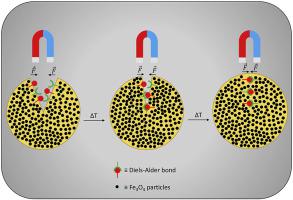Polymer ( IF 4.6 ) Pub Date : 2020-07-24 , DOI: 10.1016/j.polymer.2020.122819 Kenneth Cerdan , Guy Van Assche , Peter van Puyvelde , Joost Brancart

|
Self-healing materials have been intensively studied as materials that can mimic healing properties of biological systems. Reversible polymer networks based on Diels-Alder thermoreversible covalent bonds exhibit great healing performance by controlling the temperature of the system. Despite the attractive applications of self-healing materials, most of them are restricted to the repair of narrow cracks due to their restricted mobility in the solid state. In this work, magnetite (Fe3O4) particles are used to create self-healing magnetic composites. The use of a conventional magnet to apply a magnetic driving force is proposed for the closure of wide damage gaps in the solid state without the need of either mechanical intervention or liquid-like flow inside the material, limiting the structural stability. Thermal, mechanical and chemical characterization of different composites are performed in this study and the healing efficiency is evaluated to assess their potential to close and heal large damage sizes.
中文翻译:

一种使用磁性粒子封闭自愈弹性体中大损伤的新颖方法
自愈材料已被广泛研究为可模仿生物系统愈合特性的材料。通过控制系统温度,基于Diels-Alder热可逆共价键的可逆聚合物网络表现出出色的修复性能。尽管自愈材料具有吸引人的用途,但是由于它们在固态中的受限移动性,它们中的大多数都限于修复狭窄的裂缝。在这项工作中,磁铁矿(Fe 3 O 4)粒子用于创建自愈磁性复合材料。提出了使用常规磁体施加磁驱动力来封闭固态的宽损伤间隙,而不需要机械干预或材料内部的液体状流动,从而限制了结构稳定性。在这项研究中进行了不同复合材料的热,机械和化学表征,并评估了其愈合效率,以评估其闭合和治愈大损伤尺寸的潜力。



























 京公网安备 11010802027423号
京公网安备 11010802027423号